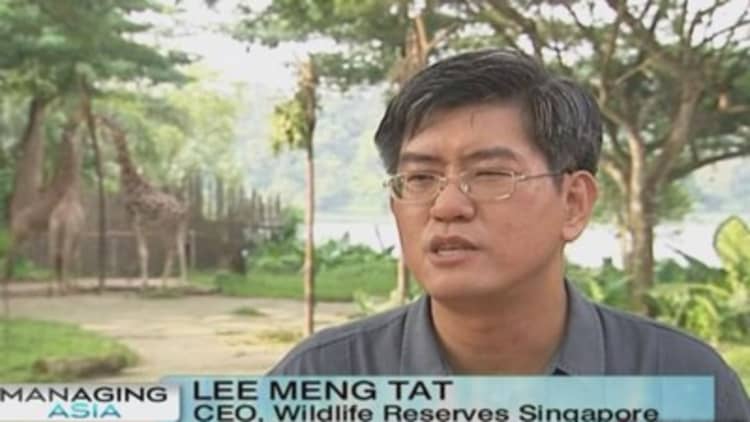
Two years after leaving the food and beverage industry where he had carved his career for the past two decades, Singaporean Lee Meng Tat is now living a wild life – quite literally.
Heading the Wildlife Reserves Singapore (WRS) which owns the Singapore Zoo, Jurong Bird Park, Night Safari and the newly-opened River Safari, the 50-year-old has nearly 13,000 animals under his charge, though he admits that he knew little about the job initially.
"I know nothing about running a zoo but after 12 years with Fraser & Neave I was looking to move on to something new," the zoo's chief executive officer told CNBC's "Managing Asia."
Read MoreSingapore putsnew spin to mocked anti-gambling ad
"[After I was approached] I took the weekend to visit the zoo. Walking around, I felt a sense of pride among the staff in their work," he said.
What he lacks in experience, the mechanical engineering graduate makes up by taking daily walks around the various parks and keeping his ear to the ground. "Every week, I meet staff for lunch just to know them and what they think of the company. I'm still doing it after two years [but] now it's about once a month."
Challenges for River Safari
Early this year, Lee added a fourth park to the WRS umbrella, its first in almost 20 years. Costing approximately $128 million, River Safari – a 12-hectare attraction with panda enclosures and freshwater animals – is a giant leap into the unknown for both Lee and the organization.
"People told me not to worry but there is a lot more competition now compared to 20 years ago. Also, adding a fourth park isn't just a simple extension; the level of complexity multiplies."
Read MoreNow the World Cup is getting blamed for ...
The WRS took on a bank loan for the first time. Apart from finances, the organization also had to get past obstacles in talent recruitment.
"Our expertise lies in land animals and the birds. We do have experience with aquatic animals but not that comprehensive. For River Safari, we had to hire people with a different skill set. We were also launching a theme park-style boat ride which is new to us. We did not have the staff to manage that," Lee recounted.
Since opening in February, the park has chalked up nearly one million visitors. Lee estimates that the attraction will take 3 to 5 years to achieve break even.
Managing costs and animal welfare
With donations comprising less than 5 percent of revenue, maintaining a clean balance sheet is paramount for the self-financed WRS which posted $94 million in revenue last year. But for Lee, the welfare of the animals remains top priority too.
"Anything to do with animals isn't commercial operation. We are a zoo after all so conservation, research and education are important to us [but] we are very mindful of profitability as we don't receive any subsidies [so] we have to make sure we earn enough to maintain our premises," he told CNBC.
Read MoreSingapore's Temasek takes it on the chin
Over 850 employees are needed to keep the four wildlife parks, which received nearly 4.7 million visitors in 2013, going. Thus, manpower costs have proven to be a challenge amid rising wages and increasing restrictions for foreign workers in Singapore. To counter that, WRS has turned to technology and outsourcing.
"We encourage self-service for example buying tickets online so as to reduce the number of ticket sellers. Cleaning and security services are outsourced to cut costs. But as far as animals are concerned, we maintain the number of staff because it's not possible to automate when it comes to that," Lee said.
— Reported by Christine Tan; Written by See Kit Tang



